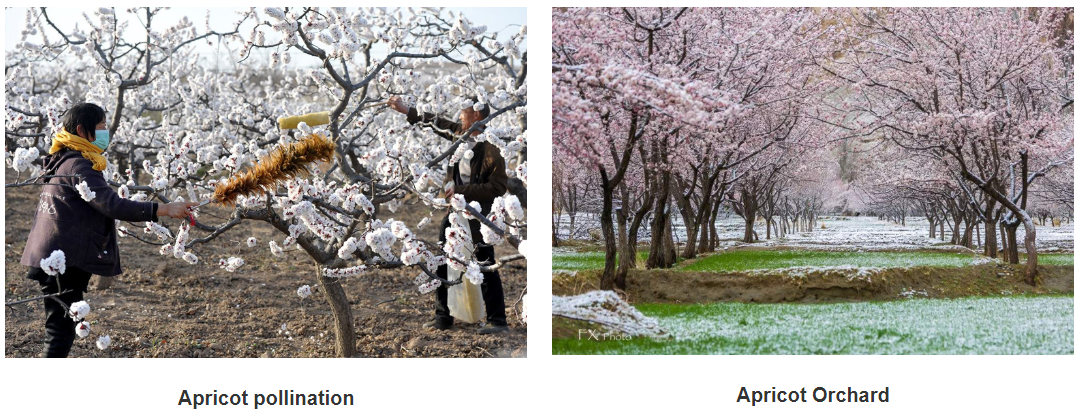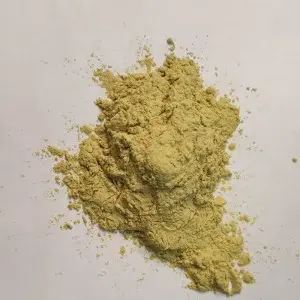Hōʻike huahana
Apricot originated in Xinjiang, China, is one of the oldest cultivated fruit trees in China. Apricot trees are planted all over China. There are also many excellent varieties. Apricot is a positive tree species with strong ability to adapt to the environment. Its roots can extend deep underground. It likes light, is drought resistant, cold resistant, wind resistant, and has a life span of more than 100 years. Muyage apricot in Shufu County, Kashi Prefecture, Xinjiang, has thick flesh, thin skin, juicy and sweet taste. It is known as the "king of apricots" and is one of the best apricots in China. There are many varieties of apricot pollen collected by our company, such as muyage apricot, Kate apricot and Golden Sun Apricot in Xinjiang, Hebei white apricot, mountain apricot and so on. The pollen of these apricot varieties has good affinity and excellent fruit genes. You can contact us to tell us what kind of variety you are planting. We will test the genetic sequencing for you and recommend you the pollen of apricot trees and high affinity varieties suitable for your orchard
Instructions: Since most fruits in the world are self incompatible varieties, although some varieties can realize self pollination, it is found that the use of cross pollination technology in the orchards of self pollinated varieties will enable farmers to have a greater harvest. Therefore, artificial pollination is strongly recommended. Although this seems to increase your planting costs, you will find how smart you are in the harvest season. According to our experiment, the conclusion is to compare the two orchards, in which orchard a adopts natural matrix pollination and orchard B adopts artificial cross pollination of specific varieties. The specific data at harvest are compared as follows: the proportion of high-quality commercial fruits in garden a is 60%, and the proportion of high-quality commercial fruits in garden B is 75%. The yield of artificial pollination orchard is 30% higher than that of natural medium pollination orchard. Therefore, through this set of numbers, you will find how wise it is to use our company’s pollen for cross pollination. Using the company’s pear blossom powder can effectively improve the fruit setting rate and quality of commercial fruits
Hoʻomalu
1 No ka ikaika a ola ka pollen, ʻaʻole hiki ke mālama ʻia ma ka lumi wela no ka manawa lōʻihi. Inā hoʻohana ʻia i loko o 3 mau lā, hiki iā ʻoe ke waiho i loko o kahi waihona anu. Inā ma muli o ke ʻano like ʻole o ka wā pua, pua mua kekahi mau pua ma ka ʻaoʻao o ka mauna, a ʻo kekahi e pua lohi ma ka ʻaoʻao malu o ke kuahiwi. Inā ʻoi aku ka manawa hoʻohana ma mua o hoʻokahi pule, pono ʻoe e kau i ka pollen i loko o ka paʻukū a hiki i -18 ℃. A laila e lawe i ka pollen mai loko mai o ka pahu paʻukū he 12 mau hola ma mua o ka hoʻohana ʻana, e waiho i loko o ka lumi wela e hoʻololi i ka pollen mai ka noho moe ʻana i ke kūlana hana, a laila hiki ke hoʻohana maʻamau. Ma kēia ala, hiki i ka pollen ke ulu i ka manawa pōkole ke hiki i ka stigma, i mea e hana ai i ka hua kūpono a mākou e makemake ai.
2. ʻAʻole hiki ke hoʻohana ʻia kēia pollen i ka wā ʻino. ʻO ka mahana o ka pollination kūpono he 15 ℃ - 25 ℃. Inā haʻahaʻa loa ka mahana, e lohi ka ulu ʻana o ka pollen, a ʻoi aku ka manawa o ka paipu pollen e ulu a hoʻonui i loko o ka ovary. Inā ʻoi aku ka kiʻekiʻe o ka mahana ma mua o 25 ℃, ʻaʻole hiki ke hoʻohana ʻia, no ka mea, ʻo ke kiʻekiʻe kiʻekiʻe e pepehi i ka hana o ka pollen, a ʻo ke kiʻekiʻe kiʻekiʻe e hoʻopau i ka hopena nutrient ma ka stigma o nā pua e kali ana i ka pollination. Ma kēia ala, ʻaʻole hiki i ka pollination ke hoʻokō i ka hopena o ka ʻohi ʻana a mākou e makemake ai, no ka mea, ʻo ka nectar ma ka pua stigma kahi kūlana kūpono no ka germination pollen. Pono nā kūlana ʻelua i luna e nānā pono a hoʻomanawanui e ka poʻe mahiʻai a i ʻole nā mea loea.
3. Inā ua i loko o 5 mau hola ma hope o ka pollination, pono ia e hoʻopili hou ʻia.
E mālama i ka pollen i loko o kahi ʻeke maloʻo ma mua o ka hoʻouna ʻana. Inā ʻike ʻia he pulu, mai hoʻohana i ka pollen moist. Ua pau ka hana mua o ia pollen.
Puna pollen: Golden Sun Apricot
Nā ʻano kūpono: ʻO ka hapa nui o nā ʻano Apricot ma ka honua. Inā pono, e ʻoluʻolu e kelepona mai iā mākou no ke kamaʻilio kikoʻī. E hana mākou i ke kaʻina hana e like me kāu ʻano like ʻole a hāʻawi i ka pollen hoʻāʻo no ka manuahi
pākēneka germination: 80%
Ka nui o ka mālama ʻana: 1600KG


